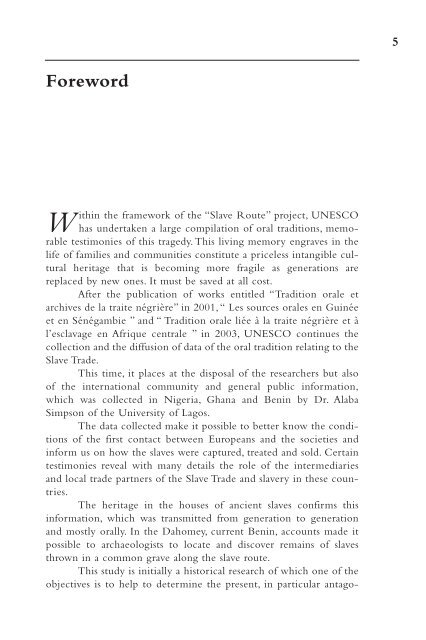Oral tradition relating to slavery and slave trade in Nigeria, Ghana ...
Oral tradition relating to slavery and slave trade in Nigeria, Ghana ...
Oral tradition relating to slavery and slave trade in Nigeria, Ghana ...
Create successful ePaper yourself
Turn your PDF publications into a flip-book with our unique Google optimized e-Paper software.
Foreword<br />
W<br />
ith<strong>in</strong> the framework of the “Slave Route” project, UNESCO<br />
has undertaken a large compilation of oral <strong>tradition</strong>s, memorable<br />
testimonies of this tragedy.This liv<strong>in</strong>g memory engraves <strong>in</strong> the<br />
life of families <strong>and</strong> communities constitute a priceless <strong>in</strong>tangible cultural<br />
heritage that is becom<strong>in</strong>g more fragile as generations are<br />
replaced by new ones. It must be saved at all cost.<br />
After the publication of works entitled “Tradition orale et<br />
archives de la traite négrière” <strong>in</strong> 2001,“ Les sources orales en Gu<strong>in</strong>ée<br />
et en Sénégambie ” <strong>and</strong> “ Tradition orale liée à la traite négrière et à<br />
l’esclavage en Afrique centrale ” <strong>in</strong> 2003, UNESCO cont<strong>in</strong>ues the<br />
collection <strong>and</strong> the diffusion of data of the oral <strong>tradition</strong> <strong>relat<strong>in</strong>g</strong> <strong>to</strong> the<br />
Slave Trade.<br />
This time, it places at the disposal of the researchers but also<br />
of the <strong>in</strong>ternational community <strong>and</strong> general public <strong>in</strong>formation,<br />
which was collected <strong>in</strong> <strong>Nigeria</strong>, <strong>Ghana</strong> <strong>and</strong> Ben<strong>in</strong> by Dr. Alaba<br />
Simpson of the University of Lagos.<br />
The data collected make it possible <strong>to</strong> better know the conditions<br />
of the first contact between Europeans <strong>and</strong> the societies <strong>and</strong><br />
<strong>in</strong>form us on how the <strong>slave</strong>s were captured, treated <strong>and</strong> sold. Certa<strong>in</strong><br />
testimonies reveal with many details the role of the <strong>in</strong>termediaries<br />
<strong>and</strong> local <strong>trade</strong> partners of the Slave Trade <strong>and</strong> <strong><strong>slave</strong>ry</strong> <strong>in</strong> these countries.<br />
The heritage <strong>in</strong> the houses of ancient <strong>slave</strong>s confirms this<br />
<strong>in</strong>formation, which was transmitted from generation <strong>to</strong> generation<br />
<strong>and</strong> mostly orally. In the Dahomey, current Ben<strong>in</strong>, accounts made it<br />
possible <strong>to</strong> archaeologists <strong>to</strong> locate <strong>and</strong> discover rema<strong>in</strong>s of <strong>slave</strong>s<br />
thrown <strong>in</strong> a common grave along the <strong>slave</strong> route.<br />
This study is <strong>in</strong>itially a his<strong>to</strong>rical research of which one of the<br />
objectives is <strong>to</strong> help <strong>to</strong> determ<strong>in</strong>e the present, <strong>in</strong> particular antago-<br />
5


